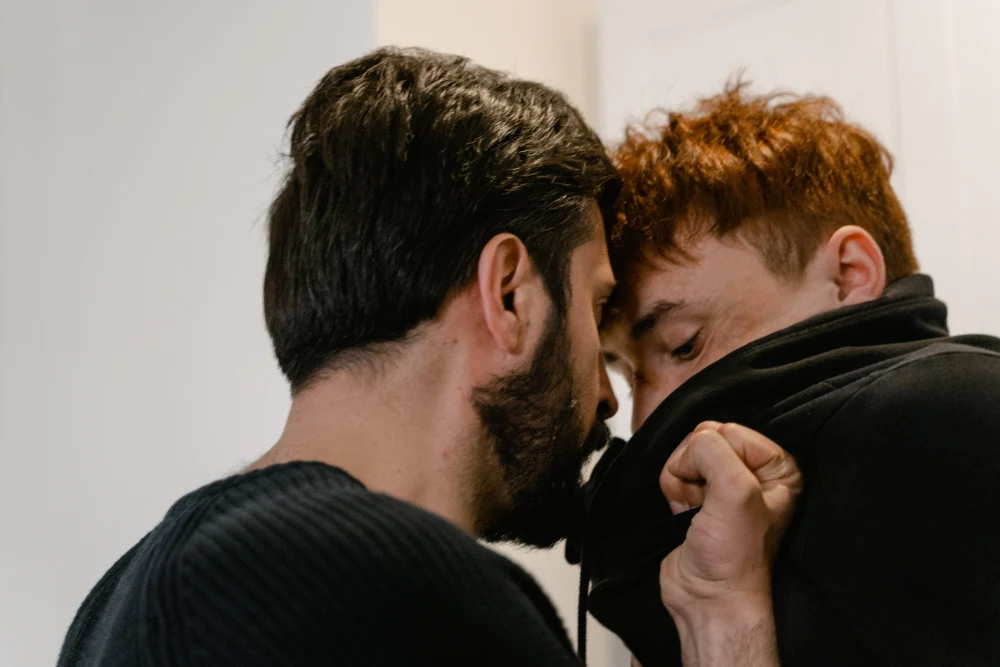Trauma bonding is a psychological response to abusive or unhealthy relationships. It occurs when the abused person forms an unhealthy attachment to the abuser.
The abused becomes emotionally and psychologically dependent on the abuser, even though the relationship causes them harm.
Trauma bonding develops due to the abuse cycle of violence followed by affection or positive reinforcement. The abuse leads to fear, while the reconciliation creates relief and gratitude in the abused.
This push-pull dynamic strengthens the trauma bond over time. The abused partner mistakenly associates the abuser with love due to this cycle.
Trauma bonds keep people stuck in abusive relationships. The abused partner feels they “need” their abuser to feel happy and secure. They downplay the abuse and make excuses for their partner’s behavior. Breaking a trauma bond is difficult but necessary to escape an abusive relationship.
Counseling and support groups can help trauma survivors process what they endured. They must recognize that their abuser’s treatment was unacceptable, regardless of any affection shown. The survivor must build self-confidence and regain their sense of self outside the relationship.
10 Signs of Trauma Bonding
Trauma bonding has distinct symptoms that can indicate an unhealthy attachment. Recognizing these signs is the first step in breaking free. The 10 red flags below can signify trauma bonding:
- Feeling like you “need” the abuser in your life.
- Making excuses for abusive behaviors.
- Having an irrational commitment to the relationship.
- Only recalling the positive aspects of the relationship.
- Feeling protective towards your abuser.
- Feeling insecure or inadequate without them.
- Hiding signs of abuse from friends and family.
- Having difficulty leaving or ending the relationship.
- Feeling hopeless when apart from your abuser.
- Trying repeatedly to leave but going back.
This article will explore each of these 10 signs in detail. Understanding trauma bonding is vital for abuse survivors. Recognizing unhealthy attachment is the only way to break the cycle. With support, survivors can regain their independence and heal from abuse.
Sign #1: Feeling Like You “Need” The Abuser
The most telltale sign of a trauma bond is an irrational sense of needing your abusive partner. Victims become emotionally dependent on their abuser through the cycle of abuse followed by affection. They form an unhealthy and obsessive attachment to their manipulative partner.
Prioritizing Abuser’s Needs
Trauma-bonded people feel that their abuser is essential to their happiness and wholeness. They believe they cannot survive or function without their abusive partner in their life. This creates a willingness to endure ongoing abuse to maintain the relationship.
Isolating Themselves
This traumatic attachment causes victims to prioritize their abuser’s needs over their own health and safety. The victim lives to please their partner and avoid triggering violence. They may isolate themselves from friends, family, or activities they enjoy to devote all their energy to the abuser.
Underplaying the Abuse
Victims underplay the abuse because they view their partner as necessary for their survival. They excuse, justify, or even deny serious harm like physical violence, emotional manipulation, verbal assaults, and sexual coercion.
Willingness to Sacrifice Themselves
No matter how terribly they are treated, the victim feels they “need” their abuser to be whole. They become willing to sacrifice more and more of themselves to maintain the relationship at any cost. This irrational feeling of needing the abuser is the core of trauma bonding.
Cutting Contact
Breaking this traumatic attachment is key to escaping abuse. The victim must recognize their own inherent worth outside of the dysfunctional relationship.
Though difficult, cutting contact with the abuser can break the spell of obsession. Therapy helps victims process the abuse and regain normal emotional functioning.
Rebuilding Independence
Building self-confidence, reconnecting with friends, and finding purpose in their lives help trauma survivors feel worthwhile again. They can recognize that they do not deserve abuse, no matter how “needed” the abuser makes them feel. This emotional independence helps victims break free of abuse.

Sign #2: Imbalanced Power Dynamics
Another hallmark of trauma-bonded relationships is a severe power imbalance that favors the abuser. Through manipulation and control, the abusive partner exerts dominance over the victim. This creates a master-servant dynamic that entraps the victim.
Tactics to Gain Leverage
Abusers use tactics like gaslighting, threats, and emotional blackmail to gain leverage in the relationship. They break down the victim’s self-esteem over time, making them compliant and unable to imagine leaving.
Feeling Helpless
Victims feel helpless to change or escape the abusive relationship due to this power differential. The abuser has eroded their confidence and conditioned dependence.
Believing Resistance is Futile
Trauma-bonded victims believe that resistance is futile. They have learned that standing up to abuse only leads to harsher punishment from the domineering partner. Victims walk on eggshells to avoid triggering violence.
Degradation and Obedience
The abuser reinforces this uneven power distribution through degradation and requiring obedience. Victims are made to feel weak, unworthy, stupid, or incompetent without their controlling partner.
Feeling Reliant on Abuser
This encourages trauma bonding by making the victim feel reliant on their abuser for survival. In truth, the abuser deliberately cripples their partner’s self-esteem as a way to retain dominance in the relationship.
Regaining Personal Power
Restoring a sense of personal power is essential for trauma survivors to break free. Counseling and support groups help victims regain confidence in themselves. Once they realize their inherent worth and ability, they can escape the abuser’s web of control.
Overcoming the Abuser’s Dominion
By understanding manipulation tactics, asking others for help, and making concrete escape plans, victims can overcome the abuser’s dominion. The path to freedom starts with recognizing the existing power imbalance and vowing to tip the scales back in their own favor.
Sign #3: Manipulation and Guilt
One of the most insidious signs of trauma bonding is the manipulative tactics used by the abuser to maintain control over the victim. Abusers will often resort to psychological and emotional manipulation, making their victims feel guilty, ashamed, and responsible for the abuse. This leads to the victim becoming trapped in a dysfunctional relationship, unable to break free.
Gaslighting
A common manipulation technique is gaslighting, where the abuser makes the victim question their own reality. The abuser may outright deny abusive events took place or downplay the severity.
This leads the victim to mistrust their own judgment and perception. They may start to believe they are “crazy” or “overreacting” when calling out abusive behaviors. The abuser uses gaslighting to evade accountability and project blame onto the victim.
Blame
Abusers are masters at blaming others, especially their victims, for their actions. They may justify abusive behavior by claiming the victim “provoked” them or made them act that way.
Blame often involves hurtful criticism, put-downs, and character attacks. The victim is made to feel they deserve the abuse. This destructive blame-shifting erodes the victim’s self-esteem and keeps them feeling powerless. The abuser avoids taking responsibility.
Threats
Abusers frequently rely on threats to elicit compliance and silence from their victims. Threats may be overt, like warnings of physical violence. Or they can be subtle, like threats to ruin the victim’s reputation or cut off financial support.
Abusers may also threaten self-harm if the victim attempts to leave. These threats play on the victim’s fears and vulnerabilities to keep them trapped in the relationship. The victim feels intimidated and afraid to speak out or leave.
Guilt and Shame
When subjected to constant manipulation, blame, and threats, the victim feels overwhelming guilt and shame. They are made to feel responsible for the abuse as if they deserve it or “brought it upon themselves.” Victims may feel shame for not being able to stop the cycle of abuse.
Guilt and shame work to further entrap victims, eroding their self-worth and making it extremely difficult for them to leave. They feel compelled to “fix” themselves or try to change the abuser’s behavior.
Breaking Free from Manipulation
The key to overcoming manipulation in trauma bonding is recognizing that the abuser alone is responsible for their behavior. No one deserves to be abused.
Victims should seek support from friends, family, and domestic violence advocates to help counteract the isolating effects of manipulation.
Counseling can also help victims regain confidence, set boundaries, and safely exit abusive relationships. Cutting contact with the abuser is essential for victims to take back control and fully heal.
Sign #4: Isolation from Others
Abusers frequently resort to tactics of isolation to increase their control in abusive relationships. By cutting off the victim’s support systems, the abuser gains more power and leverage. Isolation also serves to hide abusive behaviors from outside scrutiny.
Cutting Off Family and Friends
A key isolation tactic is driving a wedge between the victim and close family members and friends who could provide support. The abuser may actively prohibit the victim from seeing loved ones.
Or they may shower the victim with jealousy, criticism, or anger when they spend time with others. The victim starts avoiding their support network to appease the abuser or avoid conflict.
Controlling Communication
Abusers may monitor and restrict who the victim can talk to and how. They may block access to cell phones or computers. Or they may require the victim to disclose passwords and accounts.
Abusers may also constantly call or text the victim to track their activities when apart. This controlling communication isolates victims from outside relationships.
Forced Dependence
In addition to cutting off emotional support, abusers may force financial or physical dependence. They may tightly control bank accounts and finances so the victim has no access to money if they try to leave.
Abusers may prevent the victim from working or going to school. Victims may become physically disabled or lack transportation due to the abusive relationship. This forced dependence makes victims feel trapped.
Suppressing Outside Help
Abusers often prohibit victims from seeking outside help, such as counseling, domestic violence services, or medical care. Some may stalk and harass organizations or advocates who try to reach out to victims. Abusers will also avoid intervention by refusing to participate in counseling or intervention programs. They suppress outside support at all costs.
Effects of Isolation
When isolated from other positive relationships, the victim becomes consumed by the abusive relationship. The abuser essentially becomes their sole support system. This gives the abuser immense power over the victim’s emotional and physical well-being.
Victims in isolation are more vulnerable to escalating abuse and violence, with no one to intervene. Isolation also serves to normalize the abuse since victims have no objective comparisons from healthy relationships.
Restoring Support Systems
Victims should be empowered to safely rebuild support systems and relationships with loved ones. Domestic violence advocates can assist with safety planning so that separation violence is minimized. Counseling can help victims process the trauma of the abusive relationship.
Support groups can normalize experiences and provide a community of understanding. Restoring connections is critical for victims to escape isolation.

Sign #5: Minimizing and Denial
In response to ongoing abuse, victims will often start to rationalize, deny, or minimize the seriousness of the abusive behaviors. This helps resolve the cognitive dissonance between their view of the abuser and the reality.
It also serves as a psychological self-protection mechanism against full acceptance of the traumatic situation.
Excusing Abusive Behaviors
Victims may make excuses for their abuser’s behaviors and justify why they are not “that bad.” For example, victims may rationalize explosive anger as just “blowing off steam.” Or they may justify controlling behaviors as “he’s just really passionate about me.”
Victims tend to focus on the abuser’s good qualities and make altruistic attributions for their actions. This allows them to cope and preserve hope the abuser will change.
Downplaying Violence
One of the most dangerous forms of minimization is downplaying domestic violence. Victims may claim violent incidents as “not that violent” or were “not really abuse.”
They may focus on factors that “provoked” the abuser as a way to avoid labeling overtly aggressive behaviors as domestic violence. Downplaying threats and physical harm puts victims at increased risk as the abuse is likely to escalate.
Outright Denial
In severe cases, victims may outright deny the abuse is occurring at all. This may be present in extremely dangerous situations like sexual violence or sadistic physical battery.
Total denial is a desperate way for victims to preserve their relationship in the face of heinous abuse. Denial of this extreme requires intensive professional help to overcome.
Normalizing Abuse
When immersed in an abusive relationship, it becomes normalized for the victim. They have no point of comparison to healthy relationships. Victims may believe extreme jealousy, verbal assaults, and rage episodes are just part of ordinary relationship struggles. This denial makes it extremely difficult for them to recognize the need to leave.
Impacts of Minimizing Abuse
Minimizing and denying abuse can have severe consequences for victims. It prevents them from taking steps to protect themselves both physically and emotionally.
It also takes away the motivation to leave the relationship since the abuse is not acknowledged. This distortion of reality serves to bond victims closer to their abuser.
Overcoming denial
Victims should seek outside support to help counteract their own denial and minimization. Counseling can bring clarity to dysfunctional patterns. Support groups allow victims to compare their relationship struggles to those of others.
Advocacy provides information on the cycles and impacts of abuse. Overcoming denial is an essential step to breaking trauma bonds.
Sign #6: Anxiety and Depression
The psychological impacts of ongoing abuse in trauma bonding can be extremely severe. Victims often develop significant mental health conditions like anxiety, post-traumatic stress disorder (PTSD), and major depression.
Anxiety and Hypervigilance
Living in a state of constant fear leads to chronic anxiety for victims. They are anxious about triggering future incidents of abuse if they say or do the “wrong” thing.
Victims may also develop PTSD symptoms like hypervigilance and constantly scanning for threats. Anxiety causes victims to become emotionally drained and unable to function normally.
Post-Traumatic Stress
Re-experiencing trauma through intrusive memories, nightmares, and flashbacks is common in abuse victims. Any reminder can trigger extreme emotional distress.
Victims may also suffer PTSD symptoms like emotional numbing, avoiding people/places, and feeling detached. This leads to relationship problems and withdrawal from life activities.
Depression
Victims frequently suffer from major depression as a result of chronic abuse. The psychological wear from humiliation, criticism, and attacks on self-esteem cause depressive thinking.
Victims feel profoundly hopeless that their situation will ever change. Depression can be completely debilitating, impacting work, family, and self-care. Suicidal thinking may also occur.
Physical Health Impact
The constant stress of abuse also damages victims’ physical health. They may suffer from insomnia, headaches, stomach issues, and lowered immunity. Some may turn to alcohol/drugs as coping mechanisms. Abuse victims have high rates of chronic health problems.
Seeking Treatment
It is critical for victims to seek mental health treatment to cope with the traumatic effects of abuse. Therapy provides tools for managing PTSD, anxiety, and depression.
Support groups help victims realize they are not alone. Medications can also help stabilize mood and anxiety symptoms. Managing trauma is key to gaining the strength to leave.
Ongoing Recovery
Recovery from the mental health impacts of an abusive relationship occurs slowly over time, even after leaving the relationship. Victims must be patient and allow themselves time to process and heal from the trauma bonds before expecting to “get over it.” Prioritizing self-care and healthy coping strategies will support the recovery journey.
Sign #7: Intermittent Reinforcement
One of the key drivers of trauma bonding is intermittent reinforcement from the abuser. After incidents of abuse, the abuser often switches to being affectionate and attentive, which strengthens the trauma bonds. This inconsistent cycle of punishment and reward makes the relationship highly addictive.
Love Bombing
Abusers are prone to “love bombing,” where they shower the victim with over-the-top displays of affection, flattery, gifts, and promises after abuse. The victim is made to feel loved, wanted, and hopeful the abuser will change. But it quickly switches back to hostility and devaluation, leaving the victim confused.
Mixed Messaging
Abusers consistently send mixed messages to their victims, which keeps the victim off balance. One moment, they are kind and affectionate; the next, they are cruel and demeaning.
This emotional whiplash leads victims to persistently pursue the “good” abuser, hoping their love and effort will stabilize the relationship.
Partial Reinforcement
In behaviorism, partial reinforcement refers to a reward that is unpredictable or intermittent. Gambling is an example of how partial reinforcement powerfully strengthens behaviors.
Abusers dole out affection randomly and intermittently to victims, which has an addictive effect. The victim persists in hopes of being rewarded with kindness again.
Trauma Bonding
When coupled with abuse, the intermittent warmth and affection abusers display amplifies trauma bonding. The victim becomes addicted to chasing the positive reinforcement.
When they get it, their mood is boosted, and they feel bonded to the abuser. It gives them hope the abuser will permanently change.
This inconsistent cycle prevents victims from detaching from the relationship and motivates them to stay bonded to the abuser. The abuse amasses trauma, while the intermittent reinforcement deepens the addiction to the relationship.
Breaking the Cycle
Victims must recognize the manipulative tactics behind intermittent reinforcement in order to break free. Support groups can validate how addictive and confusing the dynamics are.
Counseling provides tools for avoiding self-blame when the affection inevitably disappears. Strict no contact is needed to overcome trauma bonds.

Sign #8: Learned Helplessness
When subjected to chronic abuse, victims often develop learned helplessness – a feeling of powerlessness and inability to escape, even when opportunities present themselves. This psychological state greatly contributes to trauma bonding.
Diminished Self-Worth
Constant criticism, verbal attacks, gaslighting, and other abuse tactics diminish the victim’s self-worth. Their self-esteem and self-efficacy are eroded by the abuser’s messaging that they are worthless, crazy, and incompetent. Victims come to believe they are unable to make decisions or function independently.
Taking blame
Learned helplessness causes victims to internalize blame for the abuse. They are conditioned to feel they provoked it or deserve it through their own flawed behaviors or character defects.
Victims feel guilty for upsetting their abuser and causing them to lash out. This excessive self-blame makes it impossible to recognize the option of leaving.
Not Recognizing Choices
When caught in learned helplessness, victims become passive and fail to recognize opportunities to leave. Even if outsiders point out options like staying with friends or contacting a domestic violence hotline, victims cannot identify these choices due to diminished self-efficacy. They feel trapped and doomed to endure the abuse indefinitely.
Depression
Being unable to escape despite desperate unhappiness causes severe depression. Victims withdraw and isolate themselves, seeing no possible improvement in their circumstances.
Some may turn to substance abuse as a coping mechanism. Ongoing abuse and learned helplessness can lead to suicidal tendencies.
Restoring Self-Efficacy
Through counseling and support groups, victims can be empowered to recognize they do have choices and regain self-efficacy. Building up self-esteem and challenging negative beliefs are also critical. Taking small steps like opening a separate bank account empowers victims on their path to reclaiming independence.
Sign #9: Loss of Identity
In trauma bonding, victims tend to lose their sense of identity as they become consumed by the abusive relationship. Their behaviors, goals, and entire sense of self-centers around either pleasing the abuser or avoiding further abuse. This loss of autonomy deepens the trauma bonding.
Adopting Abuser’s Views
Victims may start adopting the attitudes, opinions, and perspectives of the abuser as a survival mechanism. This includes accepting negative views about themselves that coincide with the abuser’s criticisms.
Victims relinquish their own preferences, values, and interests to better align with those of the abuser. Their sense of identity merges with that of the abuser.
Revolving Life Around Abuser
Increasingly, the victim structures their entire life around the abuser. They may isolate themselves from family and friends at the abuser’s demand. Victims stop engaging in hobbies or interests if the abuser disapproves of or discourages them.
They may also quit jobs, school, or relocate to please the abuser. The victim’s goals are abandoned, and they become defined solely by the relationship.
Walking on Eggshells
Victims become hypervigilant about preventing abuse, constantly “walking on eggshells” to avoid upsetting the abuser. They monitor and restrict their behaviors, speech, dress, and actions to keep the abuser happy. Pleasing and placating the abuser becomes their top priority at the expense of their true feelings and needs.
Loss of Autonomy
When living in fear of provoking abuse, victims relinquish more and more autonomy and decision-making power. They may yield control over finances, friendships, and major life choices to their partner.
Victims doubt their ability to make good decisions on their own. The abuser’s control over them becomes complete.
Reclaiming Identity
Victims keep journals, make art, or write stories to rediscover their voices and values. Connecting to spirituality or nature can also help victims get centered.
Counseling supports exploring buried goals and dreams. Making new friends and finding community restores a sense of self separate from the abuser. With patience, victims can reclaim their identity.
Sign #10: Walking on Eggshells
The feeling of needing to constantly walk on eggshells around the abusive partner is a core sign of trauma bonding. Victims become obsessed with trying to prevent abuse by avoiding triggers. They are hypervigilant about the abuser’s emotions.
Monitoring Moods
Victims get adept at reading subtle signs of the abuser’s shifting moods based on tone, body language, and behaviors. They analyze interactions for indications of anger or agitation.
Victims hope to catch issues early and de-escalate situations before abuse occurs. They are in a constant state of unease.
Restricting Behaviors
In their efforts to avoid “rocking the boat,” victims severely restrict their own behaviors and forms of expression. They may stop voicing opinions, avoid certain friends/family, give up activities, and dress more conservatively. Victims become afraid to be themselves, only allowing words/actions they deem “safe”.
Self-Silencing
Victims learn it is easier to remain silent and withhold their true feelings in order to avoid conflict. They train themselves never to overtly disagree, complain, or criticize the abuser. Victims silence parts of themselves in order to try to preserve the relationship. Their true emotions and needs get buried.
Caretaking
Victims get caught up in excessively caretaking the abuser’s needs to circumvent abuse. They may compulsively clean, cook favorite meals, dress a certain way, and avoid certain topics. Victims forsake their own needs, exhausting themselves trying to keep the abuser content. But abuse still occurs.
Futility of Efforts
Despite meticulous efforts to prevent blow-ups, abusers still find excuses to be abusive. Victims are made to feel they didn’t do enough to stop it. But in reality, no amount of eggshell walking can stop the cycle. Abusers abuse at their own discretion, regardless of the victim’s actions.
Stepping Off Eggshells
Leaving the relationship is the only way victims can fully stop walking on eggshells. Therapy helps build self-esteem and drop futile caretaking behaviors. Support groups validate that abuse is not the victim’s responsibility. With self-care and renewed confidence, victims can live freely.
Conclusion – 10 Signs of Trauma Bonding
Trauma bonding is a form of conditioning that occurs in abusive relationships. The victim becomes addicted to their abuser through the same mechanisms that create addiction – intermittent reinforcement, withdrawal, and psychological dependence. Recognizing the signs of trauma bonding is the first step to breaking free.
The ten signs covered here give insight into the thought patterns, behaviors, and psychological traps that connect victims to their abusers. These include denial and minimization of abuse, anxiety/depression symptoms, isolation from others, and walking on eggshells.
Abusers rely on manipulation tactics like gaslighting, threats, and blame to take control. The push-pull dynamic of kindness followed by cruelty strengthens the trauma bonds.
Victims feel helpless to leave and lose their sense of identity outside of the relationship. However, trauma bonds can be broken with the right help and increased awareness.
Victims must restore connections to supportive people and engage in self-care. Counseling and support groups can address the emotional wounds and provide coping tools.
There are many excellent resources available for victims seeking help:
- National Domestic Violence Hotline can connect victims to local resources. They offer phone, text, and online chat support.
- DomesticShelters.org lets victims search shelters and programs by zip code.
- The One Love Foundation provides online education about healthy/unhealthy relationships.
- Therapists trained in domestic violence counseling help process trauma.
- Online survivor communities provide validation and hope for overcoming abuse.
The pain of trauma bonding can feel inescapable. But victims have more strength than they realize. Reaching out for help creates hope for breaking free and healing. There is light at the end of the tunnel.





I thought you did a great job here. The language is excellent and the picture is tasteful, but you come across as nervous about what you might say next. If you preserve this walk, I have no doubt that I will return more often.
The amount of effort that you put into it was very impressive to observe. Despite the fact that the picture is appealing and your writing style is elegant, it appears that you are concerned about the fact that you ought to be providing the following content. In the event that you take care of this hike, I will almost definitely return to come back and read more of your work.
My brother strongly recommended that I visit this website, and he was entirely correct. This post truly brightened my day. You have no idea how much time I had wasted searching for this information. Thank you.